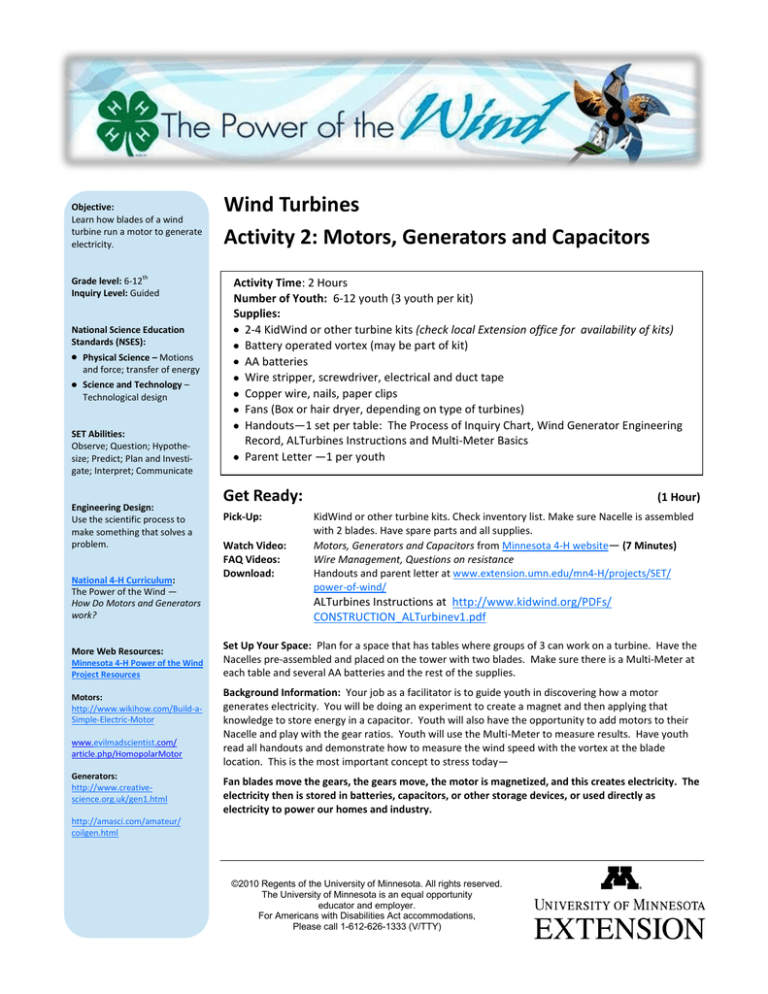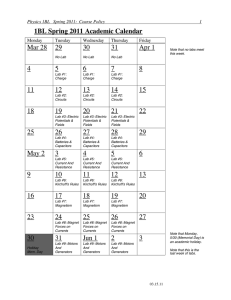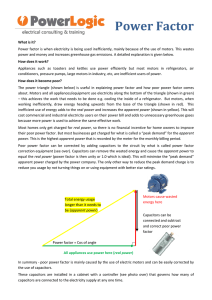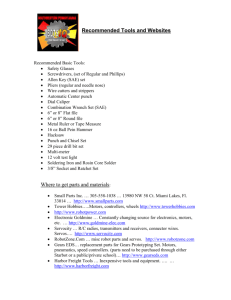
Objective:
Learn how blades of a wind
turbine run a motor to generate
electricity.
Grade level: 6-12th
Inquiry Level: Guided
National Science Education
Standards (NSES):
Physical Science – Motions
and force; transfer of energy
Science and Technology –
Technological design
SET Abilities:
Observe; Question; Hypothesize; Predict; Plan and Investigate; Interpret; Communicate
Engineering Design:
Use the scientific process to
make something that solves a
problem.
National 4-H Curriculum:
The Power of the Wind —
How Do Motors and Generators
work?
More Web Resources:
Minnesota 4-H Power of the Wind
Project Resources
Motors:
http://www.wikihow.com/Build-aSimple-Electric-Motor
www.evilmadscientist.com/
article.php/HomopolarMotor
Generators:
http://www.creativescience.org.uk/gen1.html
Wind Turbines
Activity 2: Motors, Generators and Capacitors
Activity Time: 2 Hours
Number of Youth: 6-12 youth (3 youth per kit)
Supplies:
2-4 KidWind or other turbine kits (check local Extension office for availability of kits)
Battery operated vortex (may be part of kit)
AA batteries
Wire stripper, screwdriver, electrical and duct tape
Copper wire, nails, paper clips
Fans (Box or hair dryer, depending on type of turbines)
Handouts—1 set per table: The Process of Inquiry Chart, Wind Generator Engineering
Record, ALTurbines Instructions and Multi-Meter Basics
Parent Letter —1 per youth
Get Ready:
Pick-Up:
Watch Video:
FAQ Videos:
Download:
(1 Hour)
KidWind or other turbine kits. Check inventory list. Make sure Nacelle is assembled
with 2 blades. Have spare parts and all supplies.
Motors, Generators and Capacitors from Minnesota 4-H website— (7 Minutes)
Wire Management, Questions on resistance
Handouts and parent letter at www.extension.umn.edu/mn4-H/projects/SET/
power-of-wind/
ALTurbines Instructions at http://www.kidwind.org/PDFs/
CONSTRUCTION_ALTurbinev1.pdf
Set Up Your Space: Plan for a space that has tables where groups of 3 can work on a turbine. Have the
Nacelles pre-assembled and placed on the tower with two blades. Make sure there is a Multi-Meter at
each table and several AA batteries and the rest of the supplies.
Background Information: Your job as a facilitator is to guide youth in discovering how a motor
generates electricity. You will be doing an experiment to create a magnet and then applying that
knowledge to store energy in a capacitor. Youth will also have the opportunity to add motors to their
Nacelle and play with the gear ratios. Youth will use the Multi-Meter to measure results. Have youth
read all handouts and demonstrate how to measure the wind speed with the vortex at the blade
location. This is the most important concept to stress today—
Fan blades move the gears, the gears move, the motor is magnetized, and this creates electricity. The
electricity then is stored in batteries, capacitors, or other storage devices, or used directly as
electricity to power our homes and industry.
http://amasci.com/amateur/
coilgen.html
©2010 Regents of the University of Minnesota. All rights reserved.
The University of Minnesota is an equal opportunity
educator and employer.
For Americans with Disabilities Act accommodations,
Please call 1-612-626-1333 (V/TTY)
What to do: (Directions for Youth)
Introduction:
(15 Minutes)
“Today we will be looking at magnets, motors, capacitors, gears and how they work together to generate electricity. First,
you will be doing an experiment to create a magnet. A magnet ‘orders’ your electrons so that you can get an electrical current. Then you will apply that knowledge to store energy in a capacitor. You will also have the opportunity to add motors to
your nacelle, and to play with the gear ratios. This is the key thing to remember:
Fan blades move the gears, the gears move the motor and then the motor is magnetized. After electrons are
magnetized, they are ready to be stored in capacitors, stored in batteries or used directly as electricity.
(You may want to illustrate this flow of energy on a board or flip chart.)
This is a vortex. (show) It is used to measure wind speed. In the room where we have the fan, and we have made the wind
speed constant. When you go outside and in a real world, we need to measure the wind speed. (Demonstrate use of vortex)
You should measure the wind speed with your vortex at the blade location before they begin, just to get practice. You will
use the Multi-Meter to measure your results.”
Do It!:
(1 Hour)
Activity 1: Nail, wire and battery magnet
Activity 3: What about gears?
Have youth create a magnet. Look at the illustration at the beginning of the
information video to see how this works. Have youth count the number of
paper clips their nail magnet can hold. Write the results on the board/paper.
Ask, “Why do you think some of your magnets hold more paper clips?”
“Now look at your gears. Why are they arranged the way they are? Not all of
them are arranged the same. Why? Think about that as you start to work with
the motors, gears and capacitors.”
Discuss for 10 minutes.
Activity 4: When can I work with my turbine?
Activity 2: Capacitors to the rescue!
“So you have electricity? Now what? Use it or lose it, or, you could store it!
There are several ways to store electricity. Batteries and capacitors are two
common ways to store electricity. You may be more familiar with batteries
than capacitors. So what is a capacitor? A capacitor is a passive insulated
electronic component which stores the potential difference (voltage) in an
electric field. This field stores energy and becomes magnetized. This stored
energy produces a mechanical force. When a capacitor is disconnected from
its charging circuit, it can be used like a temporary battery. This is important
in wind power generation. Energy flow needs to be consistent even though
the wind may not be.” Show the capacitors on the table. “Capacitors are an
important component in developing your wind turbine.” Discuss with your
table how you might use them as we move on with today’s activities.
“Now it’s your turn to experiment! Hook up your Multi-Meter, and place your
fan and wind turbine where you want them. Make sure you are not in anyone
else’s wind! Mark off your location with duct tape and take a measurement
with your vortex. Today we will only be experimenting with the motor/motors,
capacitors and gears.
Record your results in your KidWind Engineering Record. Look at the inquiry
chart on your table to guide you in your experimentation: question, hypothesize, plan and test, analyze and interpret. Be prepared to share what you
learned with the group.”
Encourage youth to add motors to their Nacelle and to play with the gear
ratios. Help youth start to use their Engineering Record.
Talk About It:
(30 Minutes)
Have groups present. What were their readings on their Multi-Meter? What do you think would be the biggest challenge to
using the power generated by the wind? (Use directly, store temporarily or longer term (batteries) or feed it into the grid to
be “sold back”. ) Use the Process of Inquiry Chart to guide your questions. What other energy storage ideas do you have?
Inquiry Tips:
When asking questions, recognize all possible solutions and answers
Respond with additional questions and probe for deeper learning to stimulate dialogue
It is important to stress that this activity is about experimenting that may lead to positive innovations
Closing & Clean-Up:
(15 Minutes)
“Thanks for coming today! In our next session, we will be working on blade design. If you want, you can bring materials
with you next time that you would like to use to make blades.”
Hand out the Parent Letter
This publication was developed by:
Janet Beyer, Retired Extension Program Leader
Wendy Rubinyi, Instructional Design Specialist: wrubinyi@comcast.net
Dr. Mike Lindstrom, Executive Director, SciMathMN
Dr. Gillian Roehrig, Assoc. Prof. Curriculum & Instruction
Support for this resource was provided by the 3M foundation. The 3M
Foundation invests in tomorrow’s leaders to support the environment,
energy solutions, and engineering. No endorsement of a commercial entity or its
products or services is intended or implied.





